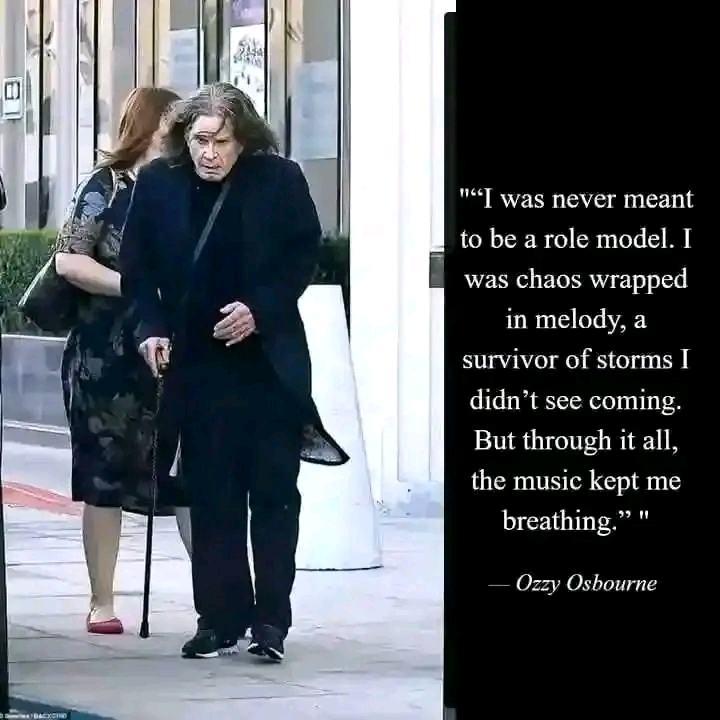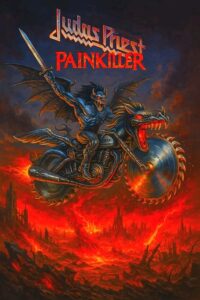
Ozzy Osbourne: The Relentless Reign of the Prince of Darkness
Born John Michael Osbourne on December 3, 1948, in the industrial heart of Birmingham, England, Ozzy Osbourne would go on to become one of the most iconic figures in music history. His voice, his presence, and his unrelenting spirit helped define not only a sound but an entire cultural movement. Known as the “Prince of Darkness,” Ozzy didn’t just ride the wave of heavy metal—he helped create it.
In 1969, alongside guitarist Tony Iommi, bassist Geezer Butler, and drummer Bill Ward, Ozzy became the frontman of a band that would go on to change everything: Black Sabbath. Their self-titled debut in 1970 was a thunderous, eerie departure from the psychedelic rock dominating the airwaves. With its haunting riffs and Ozzy’s chilling vocals, Black Sabbath introduced the world to something new—something darker. It was the birth cry of heavy metal.
Then came Paranoid (1970), a landmark album that included genre-defining anthems like “Iron Man,” “War Pigs,” and the immortal “Paranoid.” It was raw, political, and brutally honest, resonating with a generation disillusioned by war and societal unrest. Ozzy’s voice—both mournful and menacing—became the perfect channel for Sabbath’s apocalyptic soundscapes. They followed up with Master of Reality and Vol. 4, each album deepening their myth and expanding their influence.
But with success came chaos. By the late ‘70s, Ozzy’s spiraling drug and alcohol use led to increasing tensions within the band. In 1979, he was fired from Black Sabbath. It could have been the end of his story. Instead, it became the beginning of a new chapter—arguably an even more impactful one.
Just a year later, he returned with a vengeance. Blizzard of Ozz (1980), his debut solo album, exploded onto the scene. Backed by the jaw-dropping talent of young guitarist Randy Rhoads, the album delivered timeless hits like “Crazy Train,” “Mr. Crowley,” and “Goodbye to Romance.” Ozzy had found his voice again—haunting, powerful, and even more refined. Rhoads’ neoclassical metal style combined with Ozzy’s emotive wail created something magical.
Tragically, that magic was short-lived. In 1982, Randy Rhoads died in a freak airplane crash while on tour. Ozzy was devastated—but again, he carried on. Through grief, addiction, and public scrutiny, he released Diary of a Madman, Bark at the Moon, and No More Tears, with new guitar heroes like Jake E. Lee and Zakk Wylde joining his crusade. Each album had its own voice, but the constant thread was Ozzy’s authenticity. Even as trends shifted, Ozzy never pretended to be anything he wasn’t.
And then, in the most unexpected twist of his career, Ozzy became a TV star.
In 2002, The Osbournes debuted on MTV, offering a raw, hilarious, and chaotic look inside the rocker’s domestic life. Audiences fell in love with the bumbling, foul-mouthed, but oddly sweet family man behind the bat-biting legend. It made him a household name to a new generation—kids who had never heard “Sabbath Bloody Sabbath” were now quoting Ozzy’s mumbled expletives at the dinner table.
But behind the laughs was a man who had survived the seemingly unsurvivable. He battled addiction for decades, multiple near-death experiences, and more recently, serious health challenges, including Parkinson’s disease and spinal injuries. Yet through it all, Ozzy endured.
He returned for reunions with Black Sabbath, culminating in the release of 13 in 2013 and a final world tour dubbed The End. In 2020 and 2022, he released Ordinary Man and Patient Number 9, albums that wrestled with mortality but also celebrated life, resilience, and legacy. Featuring guests like Elton John, Eric Clapton, and Jeff Beck, these late-career offerings were far from nostalgia—they were statements of vitality from an artist who refuses to be silenced.

In 2006, Ozzy was inducted into the Rock and Roll Hall of Fame with Black Sabbath, finally receiving the formal recognition that the godfathers of metal so long deserved. In 2024, he received his first solo nomination—a reminder that his individual journey is as significant as the band that started it all.
What sets Ozzy apart isn’t just his music—it’s his humanity. Behind the theatrics, the controversies, and the demonic iconography is a man who feels deeply, loves fiercely, and has never hidden his scars. He’s raw. He’s real. He’s the voice of the misfits, the outcasts, and the survivors.
He’s also hilariously self-aware. Whether it’s slurring through a reality show or laughing off his infamous bat incident, Ozzy has never taken himself too seriously. And maybe that’s why we love him. In a genre full of egos and mystique, Ozzy is refreshingly honest—even when he’s dragging his demons behind him.
More than five decades into his career, Ozzy Osbourne remains a living legend—a survivor, a pioneer, and an enduring symbol of what it means to fall and rise again. His influence stretches across generations, genres, and continents. Metalheads, punks, pop stars, and even country singers owe something to the trail Ozzy blazed.
From the smoky streets of Birmingham to the stages of Madison Square Garden and beyond, Ozzy’s journey is one of transformation and triumph. He didn’t just shape heavy metal—he is heavy metal.
And even now, when he steps on stage—frail but fierce—you can still hear that unmistakable voice echo across the ages:
“I’m going off the rails on a crazy train…
”Let me know if you’d like a follow-up—maybe a piece on Randy Rhoads, the Sabbath reunion, or even a surreal story inspired by Ozzy’s “bat incident.” 🦇




